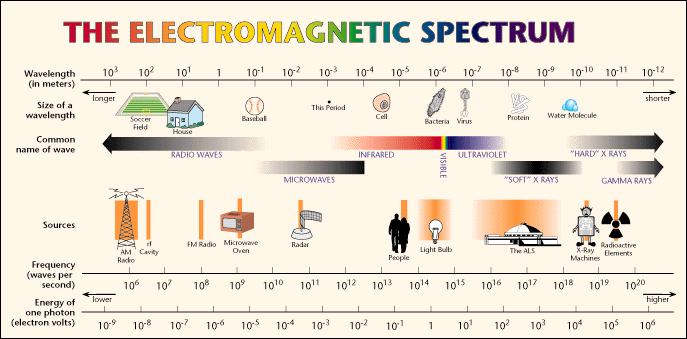
We have been on a tour of the solar system to see what is out there. We have encountered quite a variety of objects from planets, asteroids and comets, to dust and meteoroids. We tend to think that the planets are important bodies because they are the hosts of life (at least that is the case for Earth). But when you realize that 99.8% of the mass of the solar system is contained in the Sun, you quickly understand how insignificant they really are---just left over material from the Sun's formation! Today we examine the Sun more closely. We first will describe what the Sun does before we attempt to understand how it does it. Before we can understand how the Sun works, we will need to learn about atomic and nuclear physics. We will get to that stuff in the next few classes (right before the mid-term that is rapidly approaching).
Before we start on the Sun though, we must mention the electromagnetic spectrum to understand some of the pictures presented below. The human eye is sensitive to something we call "light". Light is an electromagnetic wave that carries energy. The light our eyes are sensitive to covers a very small range in energy, the small patch called "visible" in the diagram below:

High-energy forms of light (Ultraviolet, X-ray and Gamma-ray) are on the right side of this plot, while low-energy forms of light (infared, microwave and radio waves) are on the left hand side. We will talk more about this diagram soon, but for now, note that astronomers use every type of light to understand astronomical objects, and we will find that the Sun looks very different depending on what type of energy it is viewed in.
If we were to aim a camera (not recommended!) at the Sun and take a picture, we would see something like this:
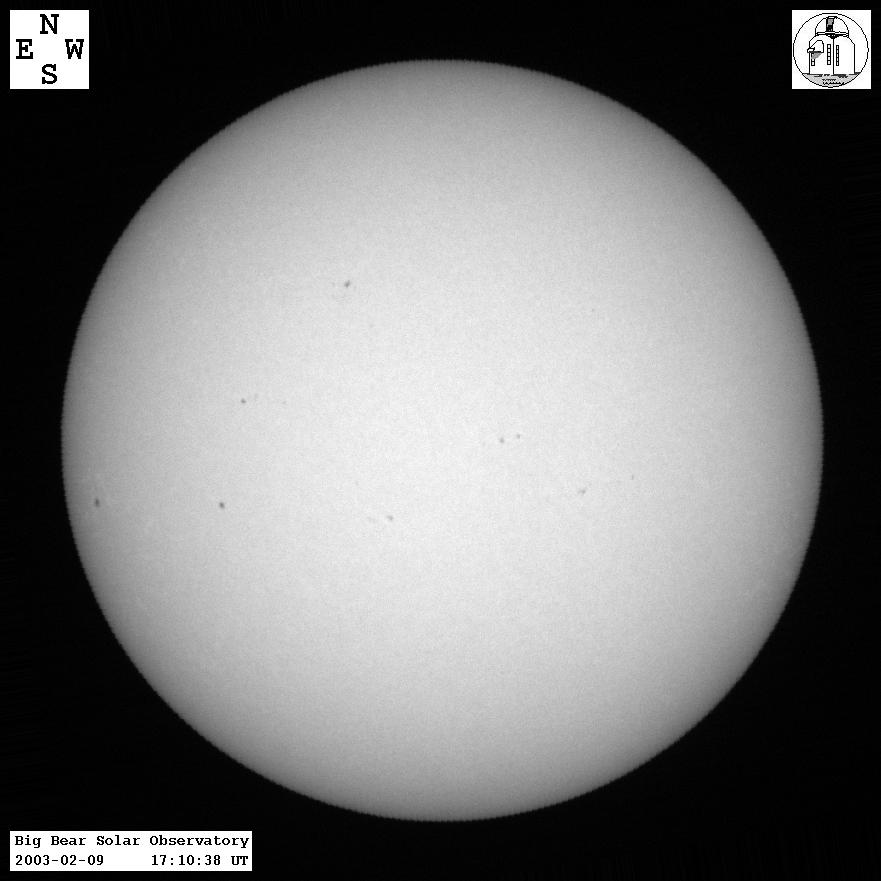
This image shows a rather smooth surface with a few small darker spots--"sunspots". If we look closer at the sunspots, we see complex detail:
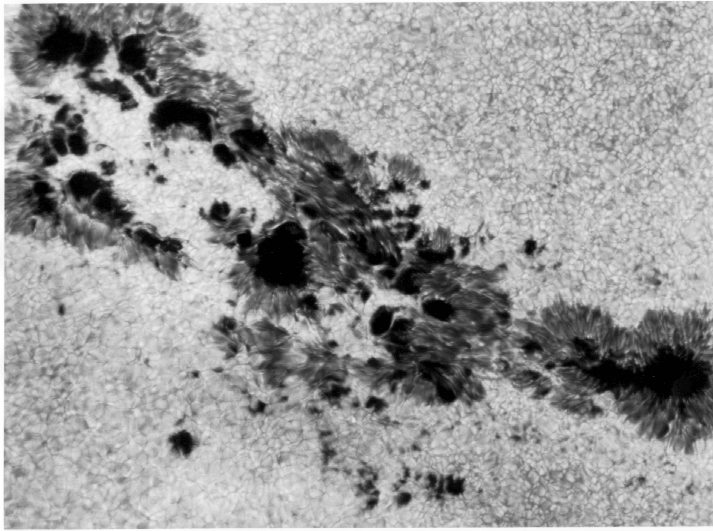
Sunspots have two distinct regions: 1)The darker cores of sunspots are called the "umbra", 2) while the feathery outer parts of a sunspot are called the "penumbra". Also notice how the Sun's surface appears to be broken-up into fine cells or pores. These structures are called the solar "granulation", and each of these tiny cells is about the size of New Mexico. If we look at the Sun using different filters, or spacecraft that allow us to see radiation that does not penetrate the Earth's atmosphere, we see a completely different looking Sun. If we look in a filter that isolates emission from the element hydrogen (we will talk about spectra and how light is emitted next week), the Sun has bright and dark patches:
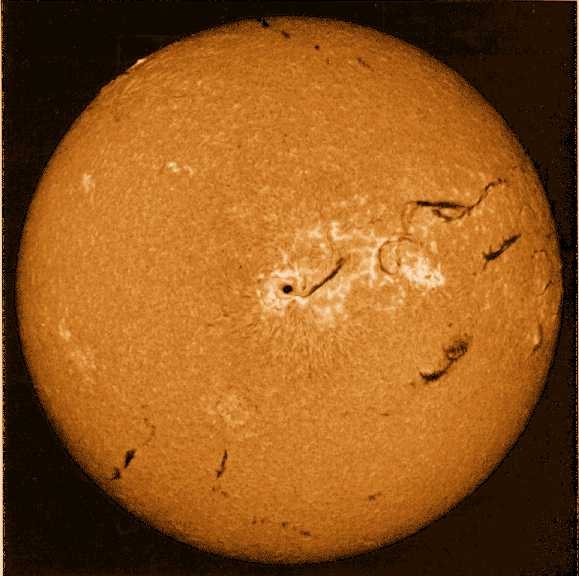
The dark linear and curved features are due to hydrogen gas that is above the surface of the Sun, and this gas is cooler (absorbing the light from below). These features are called "prominences" because when you see them during a solar eclipse (or using a special telescope) they project above the limb (edge) of the Sun:
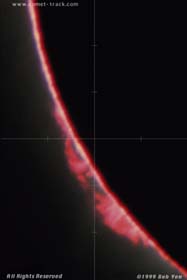
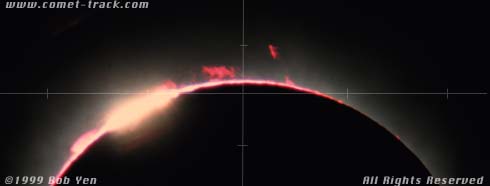
Sometimes they form beautiful loops:

The red/pink color of solar prominences is because the strongest emission line of hydrogen is in the red part of the optical spectrum (see figure 6.8 on page 159). If we use a special space-based telescope, we can look at the Sun in the ultraviolet region of the electromagnetic spectrum:

Objects that emit ultraviolet light have temperatures between 10,000 and 100,000 degrees! If we look at the Sun in the X-ray (where we are now looking at gas that is near 1,000,000 degrees), the Sun really looks different:
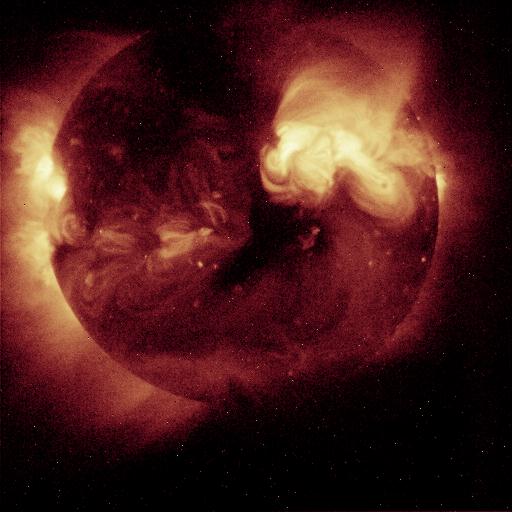
The Sun is a complicated place! What is going on here? First, let's go back to looking at the Sun in the visible part of the electromagnetic spectrum (that is where we see). The surface of the Sun that we see in the visible part of the spectrum is called the "photosphere". Photosphere means "sphere of light", that is, the surface where all of the visible light is emitted. The temperature of the surface of the Sun is 5,800 degrees Kelvin (to understand the differences between the three temperature scales of Farenheit, Celsius, and Kelvin, go here). To convert a temperature in Kelvin to Farenheit, use this formula: Temperature in Farenheit = 9x(Temperature in Kelvin - 273)/5 +32. We exclusively use the Kelvin scale in astronomy because it has no negative temperatures.
So let's get some other numbers out of the way. The radius of the Sun is 6.96 x 105 km---109 times the radius of the Earth. Remember that the volume of a sphere goes as R3, so the volume of the Sun is (109)3 = 1.3 X 106 times that of the Earth (that is, one million plus Earths could fit inside the Sun). The mass of the Sun is 2.0 X 1030 kg, about 332,000 times that of the Earth. By dividing the mass by the volume we get the mean density of the Sun: 1.4 gm/cm3. This is about the same density as Jupiter! Why does the Sun have such a low density? Because it is mostly pure hydrogen, just like Jupiter. In fact, the Sun is 70% hydrogen, and 28% helium, just like the Jovian planets (a clue to why those planets are they way they are! See the periodic table of the elements). The Sun emits an enormous amount of energy: 3.8 X 1026 Watts--that is 1024 100 Watt light bulbs! As the textbook states, if we could capture and store 1 second's worth of the Sun's energy output (called its "luminosity"), we could meet the current human demands for energy for the next 500,000 years. After the mid-term, we will place the Sun amongst the other kinds of stars and find that it is a rather average object--some stars are bigger, hotter and brighter, while others are smaller, cooler, and less luminous.
The surface of the Sun is very hot, so hot that there can be no solids or liquids--everything is gaseous (see Table 9.1 on page 232, where the "condensation temperatures", that is the temperatures below which a gas can change states into a solid--sort of like freezing, is given for common materials). Why are sunspots dark? Sunspots are magnetic storms on the surface of the Sun. They are cooler than the surrounding photosphere (about 4,500 K). Because they are cooler, they appear to be darker. Why do sunspots form in the first place? This is a much harder question to answer. Because the Sun is a big ball of gas, it does not rotate like the Earth it rotates differentially (like Jupiter). Differential rotation means that stuff near the poles rotates more slowly than the equator. This twisting rotation means that the magnetic field of the Sun is also twisted. When we get extremely twisted magnetic field lines they pop out of the solar surface creating a sunspot. This is demonstrated in Figures 15.17 and 15.22 of our textbook:
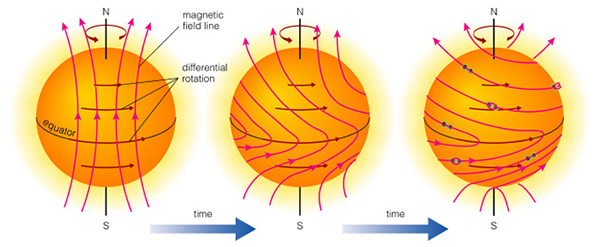
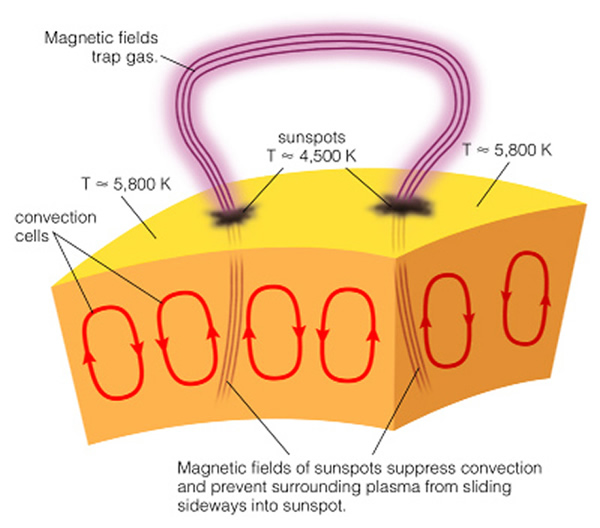
The magnetic loops connecting two sunspots are where solar prominences form. The gas follows these magnetic loops, and that's why some prominences are perfect loops like the figure shown earlier (in other prominences, there is only enough material glowing to outline part of the magnetic loop). The number of sunspots rises and falls cyclically every 11 years (actually a 22 year cycle due to the polarity of the field flipping)--the "sunspot" cycle (figure 15.21 of the text):
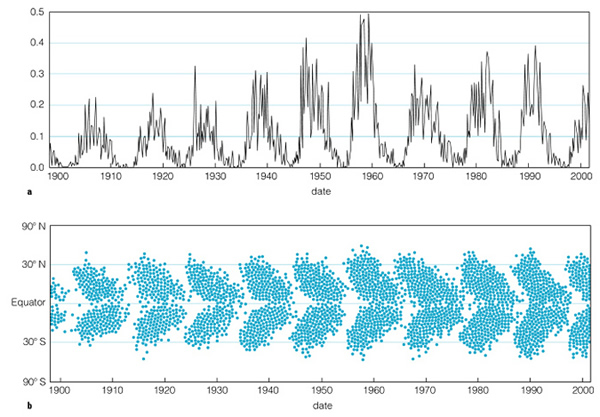
The top panel of this figure plots the number of sunspots observed each year. When there are a lot of sunspots (as in 1992 or 1959), we say the Sun is "active", when there are very few sunspots (like 1987 or 1996) we say the Sun is "quiet". The bottom panel of the last figure shows how sunspots first seem to form at latitudes of about +/-30o, as the cycle progress spots are formed at lower and lower latitudes (this diagram is sometimes called the "butterfly" diagram due to the shape of the sunspot distribution). The number of sunspots may have a large effect on global temperatures, as this figure shows:
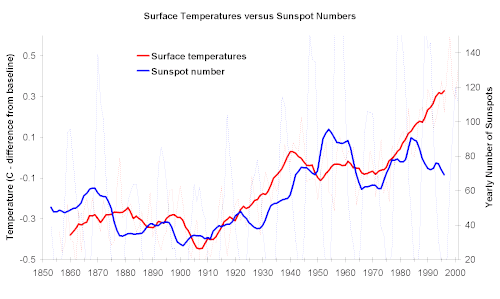
Just another issue to confuse the global warming debate! When the Sun is in an active period, all sorts of magnetic storms erupt on its surface, and these storms spew out particles that can interact with the Earth's magnetic field creating aurorae, and magnetic storms that can interfere with communication satellites, power grids, and be very dangerous times for astronauts that happen to be orbiting the Earth.
The next distinct region is called the "chromosphere", or "sphere of color". The chromosphere of the Sun is sort of like the crust of the Earth--it forms a very thin layer around the photosphere of the Sun. It isn't a crust, but actually a low-density atmosphere that is about twice as hot as the photosphere (the ultraviolet picture of the Sun shown earlier is really a picture of the chromosphere). Here is a diagram showing the structure of the Sun (textbook 15.4):
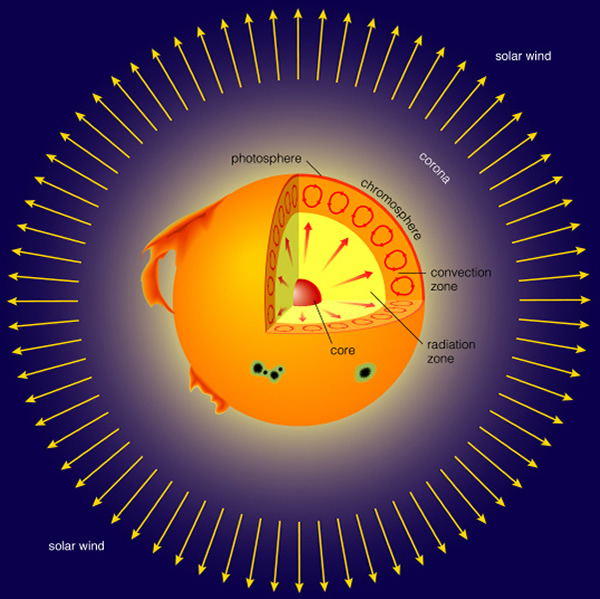
The chromosphere can only really be seen well during total eclipses, as it is relatively thin (8,000 to 10,000 km above the photosphere) region, and the photosphere emits much more light, and drowns-out the light from the chromosphere.
Above the chromosphere is the "corona":
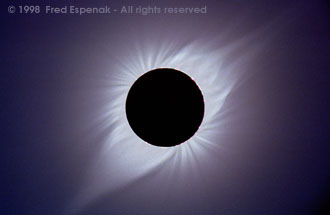
The corona extends to millions of kilometers above photosphere, and is very hot: millions of degrees! Because it is so hot, it emits most of its energy in the X-ray (as seen in the X-ray image earlier). The fine details are again due to magnetic field structures that extend out into the solar system. Some of the gas in the corona is traveling at such high velocities it can leave the Sun's gravity and travel to the Earth. This is the source of the aurora and other geomagnetic storms on the Earth. We have a wind, the "solar wind", that is flowing out in all directions from the Sun.
Now lets head inward, starting at the photosphere. The photosphere lies at the top of something called the "convective zone". Like a boiling pot of water, heat from below causes low density, and hot pockets of gas to form. These pockets of gas are "bouyant", that is they have a lower density than their surroundings and they begin to rise ("hot air rises" ). As these pockets of hot gas rise they cool, and they deposit their heat at the photosphere and then the gas sinks back down. The solar granulation structure shown earlier is actually caused by this convection. The dark edges around each solar granule is the cool, sinking gas (cooler = darker).
Below the convective zone is the radiative zone. Here the density of the surrounding gas is very high (caused by the enormous gravitational pressure from the gas lying above it). If fact, the density is so high that convection cannot work. The heat from the center of the Sun must escape somehow, and it does, through radiation (that is electromagnetic energy). In the "radiation zone", the temperature is millions of degrees, and the gas is hot enough to emit X-rays and Gamma-rays. These two forms of high energy light carry the energy outwards (through radiative diffusion--see page 508 of the text, and Figure 15.13).
Our last stop on our journey to the center of the Sun is the core. It is the core that generates the energy that powers the Sun--hydrogen fusion reactions. We will talk about hydrogen fusion next week (it is discussed, however, in section 15.3). Right now, what we simply want to describe the conditions there. The temperature at the core of the Sun is about 15 million degrees! The density is outrageous: 160 gm/cm3. This is 22 times more dense than iron, and 8 times more dense than gold (gold has a density of 19 gm/cm3, for more see the periodic table of elements). This density is caused by the great pressure of all of the gas lying above the core--not unlike the atmospheric pressure we feel on the Earth (14 lbs/in2 = 1 bar)--but here the atmospheric pressure is 200 billion times that of the Earth's atmosphere! The high temperatures and densities are what force the hydrogen atoms together to form helium that is the hydrogen fusion reaction.
How do we know how the Sun shines? This was a question that was posed several hundred years ago. The first theory was that the Sun was a burning piece of coal (of course, coal comes from decomposed vegetation!). It was quickly shown that given the Sun's current energy productions, a piece of coal wouldn't last very long. By the 17th century, it was already known that the Earth appeared to be many hundreds of thousands of years old. With Newton's formulation of gravity, it was proposed (in the late 19th century) that the Sun derived its energy from shrinking. Actually this answer is partly true--the gravitational force of such a large mass creates high densities in the center that allow nuclear fusion. This scenario seemed viable, and we now know that Jupiter generates much of its internal heat this way. These calculations showed that the Sun could last for 25 million years by slowly shrinking. But this number was already smaller than the proposed age of the Earth by a factor of two or more. By the turn of the century (around 1907), it was discovered that the Earth was in fact billions of years old (more on this next class). It was not until the discovery by Einstein of the equivalence between mass and energy (E = mc2) did the correct explanation for the source of the Sun's power become apparent.
You might ask how we know about the inside of the Sun. Well the short answer is we do not know as much as we would like to know, but there are ways to probe the solar interior. Back in chapter 10 we briefly encountered how earthquakes are used to probe the interior of the Earth (see page 257). Seismic waves bounce around inside the Earth and allow us to probe the internal structure. Something similar happens in the Sun. The Sun is a big ball of gas, and it can "vibrate" like the Earth--think of a bowl of Jello, you can make it shimy and shake in all kinds of ways. The Sun is also shaking. But the Sun can only shake and shimy in certain ways (because of gravity). The way the Sun vibrates allows us to probe the internal structure. High-speed shaking is caused by motions in the convection zone, while slow "pulsating" is due to deeper motions. An example of these motions is shown in figure 15.9 of the textbook:
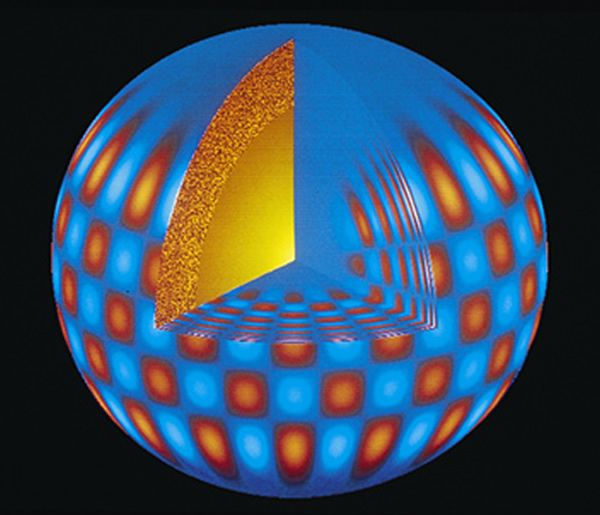
This figure actually is rather difficult to understand without a lot of mathematical insight. What it shows, however, is that there is a pattern of rising gas (blue regions) and falling gas (red regions). To set up such an ordered pattern, the Sun's interior is pulsating at a certain frequency. This frequency tells us about the internal structure. All I am trying to show here is that astronomers have ways to probe the inside of the Sun, just like geologists do with the Earth (much research on understanding the nature of the Sun has been carried out at the National Solar Observatory located near Cloudcroft, NM in the Sacramento mountains. They have a number of displays that you can see on a walking tour, including current images of the Sun--when it is not cloudy).
Solar Activity movie: Here is a movie to show how the Sun behaves, and in this movie we step from a visible light image, to Ultraviolet, to X-ray. Allowing us to see the photosphere, the chromosphere and the corona--note how dynamic the Sun is!